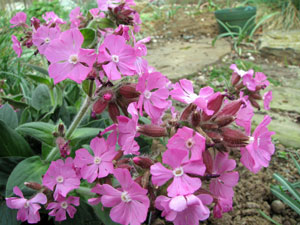Resource Library
Plant of the Week: Rolly’s Favorite Catchfly
The University of Arkansas System Division of Agriculture does not promote, support or recommend plants featured in "Plant of the Week." Please consult your local Extension office for plants suitable for your region.
Plant of the Week
Rolly’s Favorite Catchfly
Latin: Silene ‘Rolly’s Favorite’

We all like to think of ourselves as fair, unbiased and open-minded, but the reality oftentimes strays wide of the mark. Past experiences, firmly held beliefs and general misconceptions get in the way to shape our world view. A few years ago, when I picked up a plant labeled Silene ‘Rolly’s Favorite’ (PP 17,392) in a big box store, I assumed it would give a nice show the first season but then soon disappear from the garden like all of the other catchflies I have grown. But, as often as not, assumptions are often wrong.
Rolly’s catchfly is a clump-forming perennial herb in the carnation family that, for
me, makes a foot tall and wide clump when in bloom. It forms a short, densely branched
crown of foliage, with basal leaves as much as 5 inches long, entire and slightly
pubescent on the upper surface. For me, the leaves remain evergreen to around 15 degrees,
with new growth beginning to appear in late winter.
The bubblegum-pink flowers appear in early spring and are produced in profusion for
about two months, and then occasionally during the remainder of the year. Flowers
are produced in open terminal cymes on leafy, pubescent stems that are produced from
the basal crown. Each inflorescence will bear up to 20 inch-wide five-petaled, non-scented
flowers. The flower petals are broad but cleft down the middle, almost to where the
petal makes its right angle bend to fit into the maroon-colored inflated and striated
calyx. At the base of each petal, a crown of white tissue forms around the throat
of the flower to create a nice contrast to the pink blooms. Individual blossoms persist
about a week, and the entire inflorescence will remain in bloom for about a month.
Rolly’s Favorite was discovered growing in a seed lot by H.G. Oudshoorn of the Netherlands in 1998, with the plant patent granted in January of 2007. The plant patent was issued under the name Lychnis ‘Rolly’s Favorite’, assuming the plant to be a seedling of L. flos-jovis, a European wildflower called the Flower of Jove; but today most sources now list Rolly’s Favorite as a kind of Silene. What gives?
These two genera are very closely related, differing primarily in the presence of sticky stems found in Lychnis and technical details of the flowers. Rolly’s Favorite does not look much like L. flos-jovis, so the assumption is that it is almost certainly a hybrid, probably with a species of Silene. Many taxonomists now combine these two genera, fitting them all into the genus Silene. Taxonomically speaking, there is a lot less paperwork involved if you adopt the name Silene instead of going to the effort of creating a new intergeneric hybrid species between Lychnis and Silene. Just to keep things interesting, many list this plant under the name S. x robotii, a hybrid name I can find no valid reference to. Original spellings of the cultivar also enter into the confusion, with “Rollies” and “Rolley” both common in nursery lists. Mr. Oudshoorn gives no indication in his patent application who Rolly might be.
Rolly’s Favorite does best in a well-drained but moist site where it is protected from the hot afternoon sun. In my bright but shaded rock garden, it appears to be thriving and has now lived four years, a long life compared to other Silene species I have grown. It is hardy from zones 5 through 9. Deadheading will encourage repeat bloom. I have seen no indication of reseeding as often occurs in Lychnis, but not Silene, at least according to my experience here in northwest Arkansas.
By: Gerald Klingaman, retired
Retired Extension Horticulturist - Ornamentals
Extension News - January 6, 2012
The University of Arkansas System Division of Agriculture does not maintain lists of retail outlets where these plants can be purchased. Please check your local nursery or other retail outlets to ask about the availability of these plants for your growing area.